What’s the first star that comes to mind when you are asked to name one? Chances are you thought of the North Star. But do you really know it?
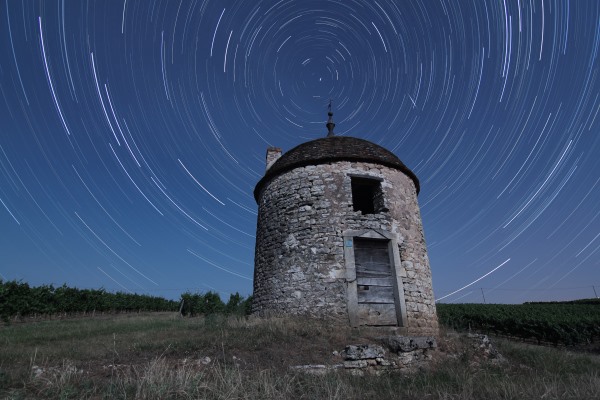
Quiz: True or False?
1. The North Star is the brightest star in our sky.
2. The North Star is also called the Morning Star.
3. The north indicated by the North Star is the same north indicated by a compass.
Find the answers at the bottom of the page!
Where is the North Star?
The North Star can be seen every night of the year from the Northern Hemisphere. And it is easy to find! Just pinpoint the most renowned constellation of all, the Big Dipper. The Big Dipper’s “bowl” is made up by its four main stars. Locate the two stars at the end of the Big Dipper (away from the handle). From there, imagine a line that extends about five times beyond them, and you’ll come across the North Star. The North Star is the brightest star in the constellation Ursa Minor (also known as the Little Dipper, or Little Bear).
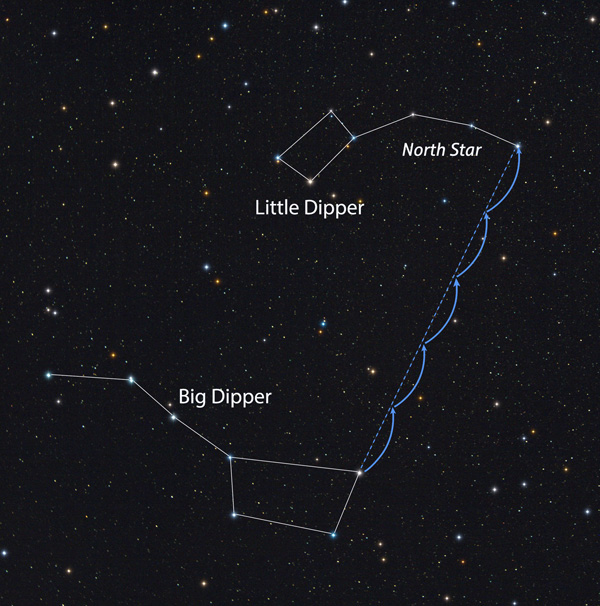
The North Star got its name because it is just about inside the north celestial pole, which is in line with the Earth’s rotational axis to the north. As our planet rotates on its axis (taking about 24 hours to make a full round), the stars around the north celestial pole seem to move with it, while the north celestial pole itself appears to stay put. Because the North Star is in this area, it also looks like it is motionless in the sky. Because of this, the North Star plays an important role:
- all the other stars seem to turn around it;
- it indicates the north!

The North Star Throughout History
The North Star is extremely helpful in determining direction and has throughout the years carried a great deal of symbolic meaning. For the Yakuts, it was considered “the navel of the sky,” and for the Sámi people, it was known as the hub of the heavens.
The Assyrians of ancient Mesopotamia called it “Stella Maris” (the star of the sea) since it was essential for celestial navigation at sea.
Generations of sailors from various civilizations depended heavily on the North Star to help guide their ships up until the invention of modern instruments like the compass, making this celestial object quite symbolic for seafarers all around the world.
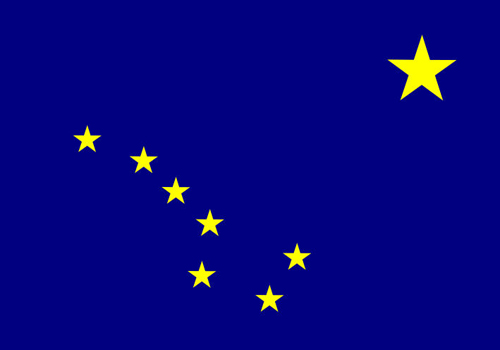
The North Star is also found on Alaska’s state flag, next to the Big Dipper. The state adopted this flag in 1927 after 13-year-old Benny Benson won the state competition calling for an original design. He explained his choice by saying, “The North Star is for the future state of Alaska, the most northerly in the Union.”
It goes without saying that the North Star has been held in high regard from ancient times to present day.
One Name, Many Stars
However, this star that has guided us for centuries may in fact have led us astray… Since, in reality, it’s not always the same one! But don’t worry, this change does not happen within a human lifetime. In fact, it takes several centuries for this to take place.
Though they may appear to stay put, the celestial poles (corresponding to the two directions of the Earth’s axis of rotation), actually move in the sky. What does this mean? Well, to understand the science behind it, we must understand that the Earth is slightly flat and has what is called an equatorial bulge. Because our planet’s axis of rotation is tilted, the equatorial bulge is not aligned with the plane of Earth’s orbit around the Sun (also known as ecliptic plane). However, the Sun and Moon’s gravitational pull act along this bulge to bring it back into the ecliptic plane. The result? The Earth’s axis of rotation moves about in a strange way, looking very much like a slowly spinning top, turning round and round against its backdrop of stars. This movement is called precession and takes about 26,000 years to complete a full circuit. During this time, several stars will replace the role of our beloved North Star.
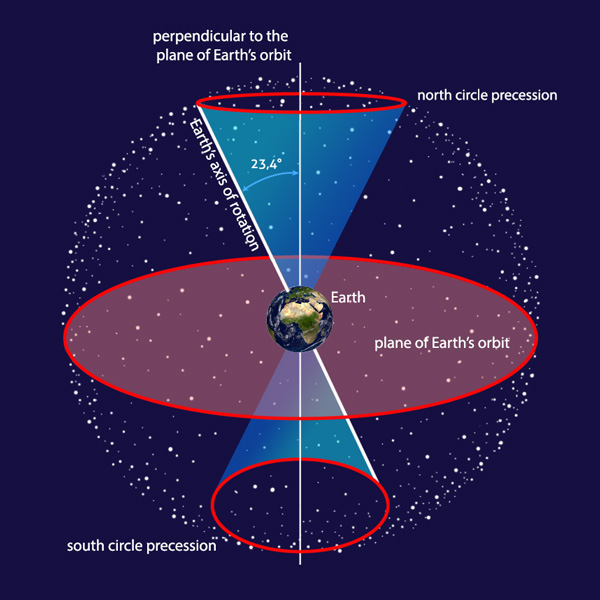
This role has changed hands a few times over the past millennia. It was first taken on by Thuban (Alpha Draconis) in 3000 BC, and then Kochab (which means “North Star” in Arabic and is today known as Beta Ursae Minoris) from 1500 BC to AD 500. Alpha Ursae Minoris, the brightest start in the constellation Ursa Minor (Little Dipper, Little Bear), currently holds this important role. In 2,000 years, Errai (Gamma Cephei) will take over for the role of the North Star and then it will be brilliant Vega’s (Alpha Lyrae) turn in about 12,000 years.
We are lucky, because our North Star is currently very close to the north celestial pole. In 2017, the angular distance between the two was measured at around 0° 40′. This will continue to decrease until the year 2102, when it reaches 0° 27′ 30”. This distance cannot be seen with the naked eye, but you’ll be able to locate due north whenever you spot the North Star. However, if a more precise location is needed, you’ll require something a bit more powerful. For example, astrophotographers must take this distance into account when they are aligning their telescopes. This can be done with a specific star diagonal which indicates Alpha Ursae Minoris’ placement from year to year.
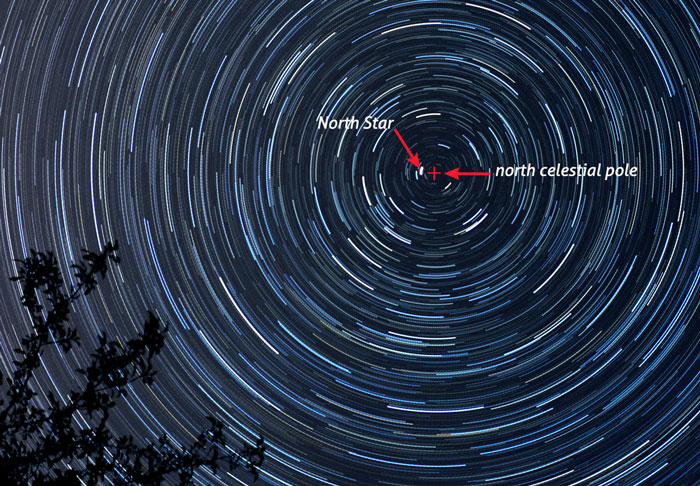
What about from the Southern Hemisphere? The North Star cannot be seen from the Southern Hemisphere. Star gazers in this part of the world actually turn towards the other celestial pole (the south celestial pole) to observe the sky. Unfortunately, there are currently no bright stars near it! However, the stars of the famous Southern Cross constellation can be used to find celestial and due south.
A Stellar Portrait
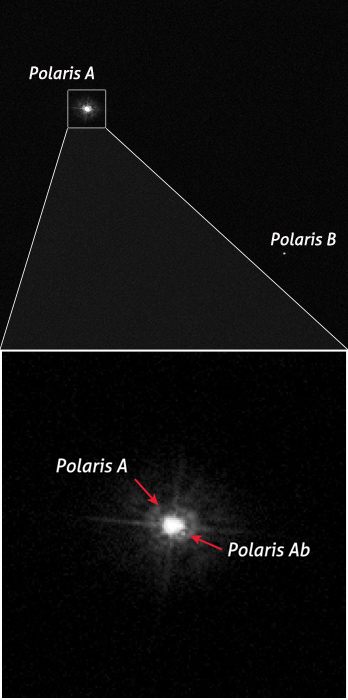
The North Star (“Polaris” in Latin) is a supergiant! In fact, it is eight times the mass of our Sun and 2,000 times brighter—but because it is 430 light years away from the Earth, its magnitude is only 2. Its white-yellow color indicates a surface temperature around 6,800°C (12,272°F!).
And, like many other stars in the Universe, we now know that the North Star is a multiple star system! Its first companion star was discovered by British astronomer William Herschel in 1780. This star is known as Polaris B and can be found using a simple telescope with a decent diameter. It has a magnitude of 9 and is 18.4’’ away from the primary star, Polaris A. And in 2005, scientists found through the Hubble Space Telescope yet another companion close to Polaris A. This star is much smaller and is known as Polaris Ab.
Unfortunately, these partner stars cannot be seen with a simple telescope. But anyone with a pair of binoculars can still marvel at the gorgeous asterism known as the Engagement Ring, of which the North Star is the diamond!
Another thing to add to the North Star’s appeal? This star (Polaris A) also varies in brightness by a few percent across its 3.97-day cycle. When this variation in brightness was discovered in 1899, it was greater than 0.1 magnitude. But this star continues to surprise us… Unlike any other star, its brightness also changes with time! In 1983, it only had a magnitude of 0.05. In 1992, this increased to 0.01, and then again in the 2000s. The North Star continues to keep us on our toes, beginner star gazers and scientists alike!
Quiz Answers
1. FALSE. The North Star is only the 48th brightest star in our sky! First place goes to… the Sun, which lights up our days. And, at night, the star Sirius in the constellation Canis Major is the brightest of them all. But take note! Venus and Jupiter can also steal the show with their brightness, which can overtake that of Sirius.
2. FALSE. The Morning Star is actually… the planet Venus! Visible towards the west in the evening or towards the east in the morning, Venus is always close to the ecliptic plane and therefore always far from the celestial poles.
3. NOT QUITE TRUE. The North Star is used as a landmark to find the geographic North Pole. A compass’ needle is aligned with the magnetic poles of the Earth—though they aren’t to be confused with the geographic poles! In 2017, the North Magnetic Pole is about 330 kilometers (205 miles) away from the Geographic North Pole and is moving at a speed of about 55 kilometers (34 miles) per year towards Siberia.
Author: Carine Souplet Illustrations by the author unless otherwise stated. Translated by Natalie Worden